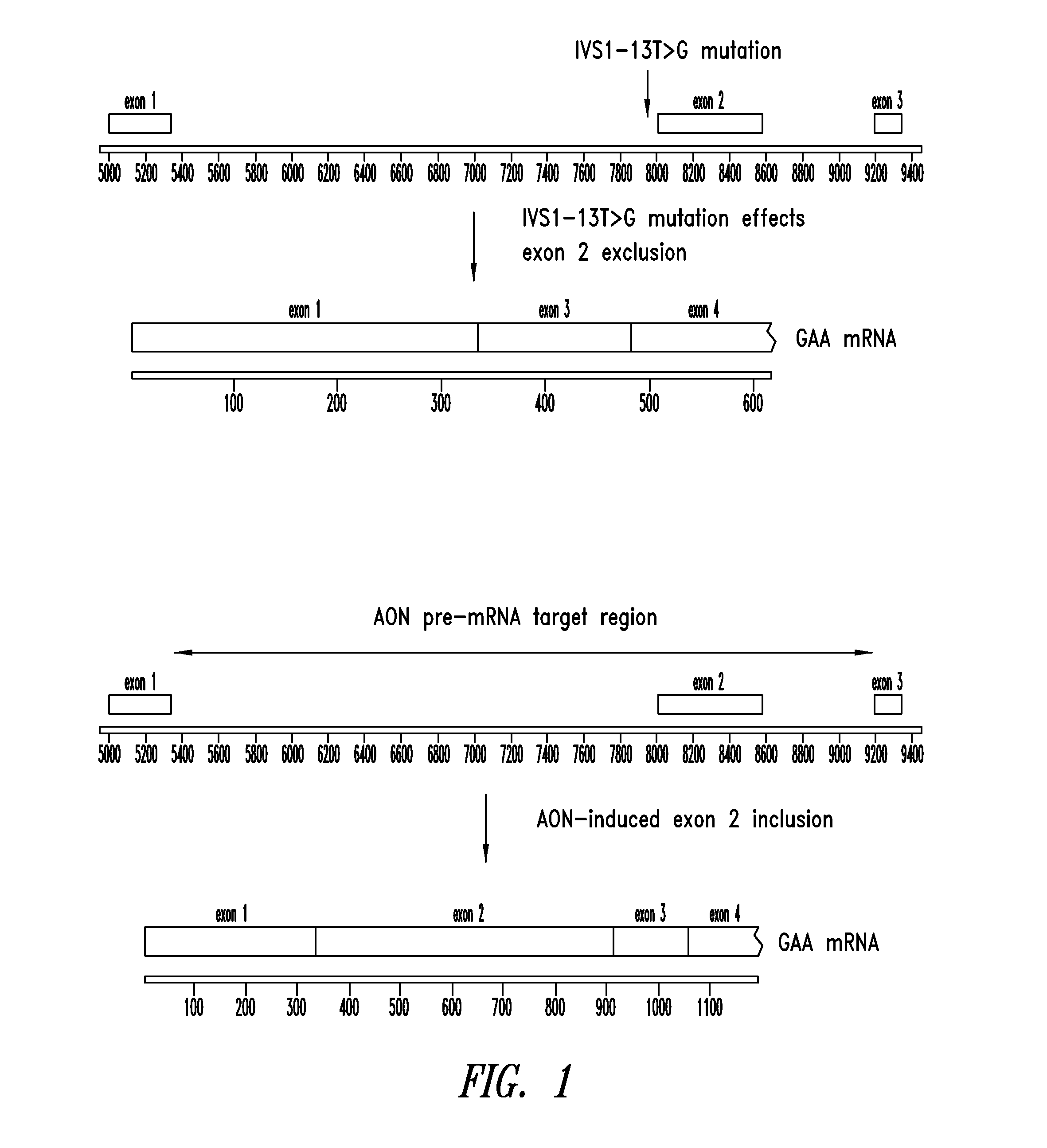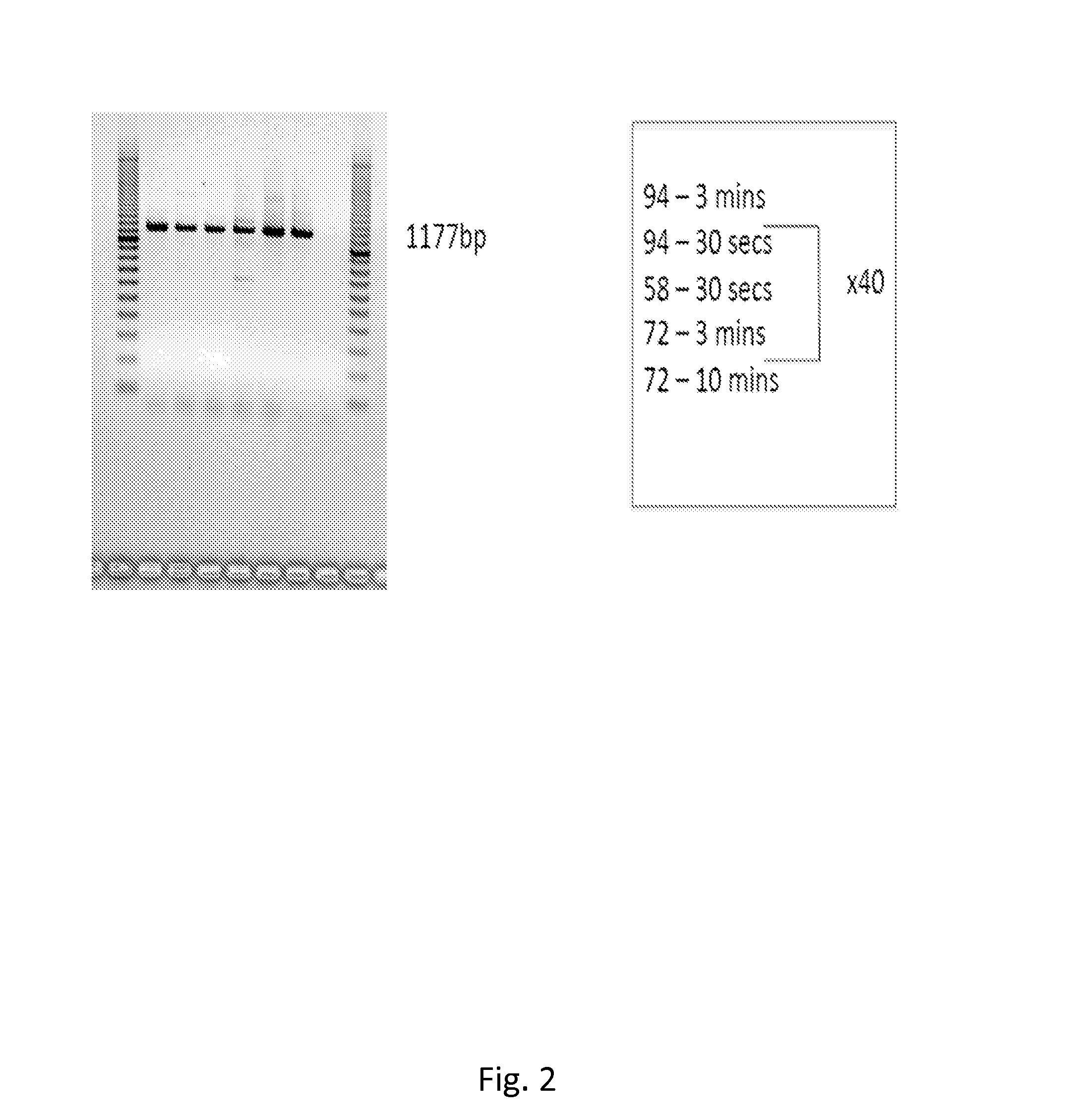Antisense-induced exon2 inclusion in acid alpha-glucosidase
an acid alpha-glucosidase and exon2 technology, applied in the field of antisense oligomers, can solve the problems of progressive muscle weakness and respiratory insufficiency, and achieve the effect of increasing the level of exon 2-containing acid alpha-glucosidase (gaa) mrna and increasing the level of exon 2-containing gaa mrna
- Summary
- Abstract
- Description
- Claims
- Application Information
AI Technical Summary
Benefits of technology
Problems solved by technology
Method used
Image
Examples
example 1
Design of Antisense Targeting Sequences
[0271]Antisense oligomer targeting sequences were designed for therapeutic splice-switching applications related to the IVS1-13T>G mutation in the human GAA gene. Here, it is expected that splice-switching oligomers will suppress intronic and exonic splice silencer elements (ISS and ESS elements, respectively) and thereby promote exon 2 retention in the mature GAA mRNA. Restoration of normal or near-normal GAA expression would then allow functional enzyme to be synthesized, thereby providing a clinical benefit to GSD-II patients.
[0272]Certain antisense targeting sequences were thus designed to mask splice silencer elements, either within exon 2 of the GAA gene or within its flanking introns. Non-limiting examples of potential silencer element targets include hnRNPA1 motifs (TAGGGA), Tra2-β motifs, and 9G8 motifs. In silico secondary structure analysis (mFold) of introns 1 and 2 (IVS1 and IVS2, respectively) mRNAs was also employed to identify l...
example 2
Antisense Oligomers Induce Exon 2 Inclusion in GSD-II Patient-Derived Fibroblasts
[0275]Experiments are performed to test the ability of antisense oligomers to induce exon 2 inclusion in fibroblasts and / or lymphocytes derived from individuals with GSD-II. In one set of experiments, 2′-O-methyl modified antisense oligomers are prepared according to standard protocols and transfected into GSD-II patient-derived fibroblasts and / or lymphocytes carrying the IVS1-13G>T mutation. In another set of experiments, PMOs are prepared according to standard protocols and introduced into these same cells by nucleofection. Levels of exon 2-containing mRNAs are then measured by RT-PCR.
[0276]GSD-II cells. Patient-derived fibroblasts or lymphocytes from individuals with GSD-II (Coriell cell lines GM00443, GM11661, GM14463 and / or GM14484) are cultured according to standard protocols in Eagle's MEM with 10% FBS. Cells are passaged about 3-5 days before the experiments and are approximately 80% confluent a...
example 3
Antisense Oligomers Induce Elevated Levels of Enzymatically Active Acid Alpha-Glucosidase in GSD-II Patient-Derived Fibroblasts
[0289]GSD-II patient cells treated with the antisense oligomers of the disclosure (as described above) are shown to have elevated levels of functional / active GAA due to increased expression of exon 2-containing GAA mRNA. Treated cells are prepared and protein is extracted using standard protocols. Protein concentration is determined and defined quantities of extracted protein are measured for GAA enzyme activity. Antisense oligomers that induce higher levels of GAA are preferred embodiments of the disclosure.
PUM
 Login to View More
Login to View More Abstract
Description
Claims
Application Information
 Login to View More
Login to View More - R&D
- Intellectual Property
- Life Sciences
- Materials
- Tech Scout
- Unparalleled Data Quality
- Higher Quality Content
- 60% Fewer Hallucinations
Browse by: Latest US Patents, China's latest patents, Technical Efficacy Thesaurus, Application Domain, Technology Topic, Popular Technical Reports.
© 2025 PatSnap. All rights reserved.Legal|Privacy policy|Modern Slavery Act Transparency Statement|Sitemap|About US| Contact US: help@patsnap.com



